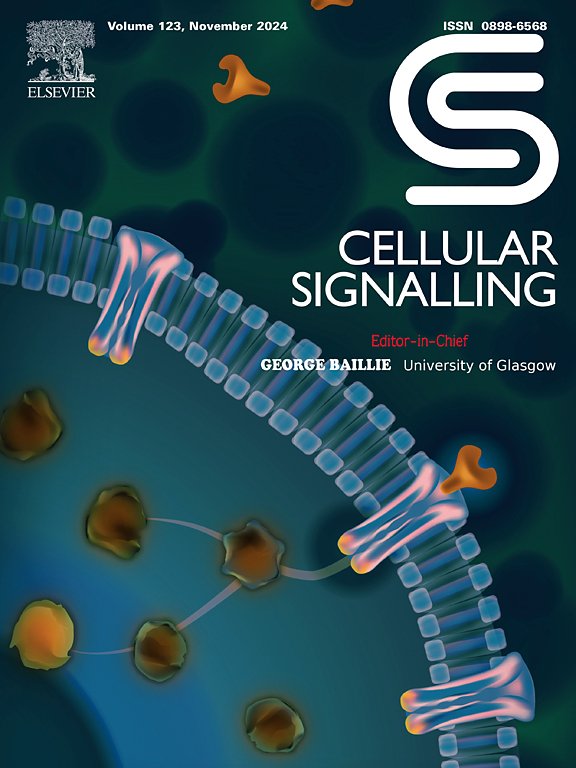生物钟基因PER2通过促进Caspase-8/RIPK3/ASC复合物的形成,促进口腔鳞状细胞癌的PANoptosis
IF 3.7
2区 生物学
Q2 CELL BIOLOGY
引用次数: 0
摘要
目前的研究表明,生物钟基因PER2在预防肿瘤中起着重要作用。然而,其在口腔鳞状细胞癌(OSCC)中的具体作用机制尚不清楚。虽然已知PANoptosis对肿瘤抑制至关重要,但尚未确定PER2是否通过调节这一过程发挥其抗癌作用。通过生物信息学分析,我们的分析发现,panoptosis相关基因(MAP3K7、CASP8)与OSCC患者的预后有显著相关性。在OSCC细胞系(NOK、CAL27、SCC25、SCC15)和临床样本中,PER2的表达与CASP8呈极显著正相关,与MAP3K7呈负相关。PER2过表达显著抑制OSCC细胞增殖,促进细胞凋亡,增加乳酸脱氢酶释放和PANoptosis标志物(cleaved caspase-3、N-GSDME、p-MLKL)的表达。与体外实验结果一致,体内肿瘤异种移植实验表明,PER2表达升高抑制肿瘤生长并上调PANoptosis标记物的表达。在机制上,PER2结合并稳定Caspase-8蛋白,促进Caspase-8/RIPK3/ASC复合物在OSCC细胞中的形成。值得注意的是,Caspase-8抑制剂Z-IETD-FMK显著逆转了OSCC细胞的PANoptosis。本研究首次证明PER2过表达通过调节Caspase-8/RIPK3/ASC复合物介导的PANoptosis来抑制OSCC增殖,为OSCC的治疗提供了一个有希望的策略。本文章由计算机程序翻译,如有差异,请以英文原文为准。
The biological clock gene PER2 promotes PANoptosis in oral squamous cell carcinoma by facilitating the formation of the Caspase-8/RIPK3/ASC complex
Current research indicates that the circadian clock gene PER2 plays a significant role in preventing tumor. However, its specific mechanism of action in oral squamous cell carcinoma (OSCC) remains unclear. While it is known that PANoptosis is critical for tumor suppression, whether PER2 exerts its anti-cancer effects by regulating this process has not been determined. Through bioinformatics analysis, our analysis revealed that PANoptosis-related genes (MAP3K7, CASP8) significantly correlate with the prognosis of OSCC patients. In OSCC cell lines (NOK, CAL27, SCC25, SCC15) and clinical samples, PER2 expression demonstrated an extremely positive correlation with CASP8 and a negative association with MAP3K7. The overexpression of PER2 significantly suppressed OSCC cell proliferation, promoted apoptosis, and increased both lactate dehydrogenase release and the expression of PANoptosis markers (cleaved caspase-3, N-GSDME, p-MLKL). In agreement with the in vitro findings, tumor xenograft experiments in vivo demonstrated that elevated PER2 expression inhibits tumor growth and upregulates the expression of PANoptosis markers. Mechanistically, PER2 binds to and stabilizes Caspase-8 protein, facilitating formation of the Caspase-8/RIPK3/ASC complex in OSCC cells. Notably, treatment with the Caspase-8 inhibitor Z-IETD-FMK markedly reversed PANoptosis in OSCC cells. This study provides the first evidence that PER2 overexpression suppresses OSCC proliferation by regulating the Caspase-8/RIPK3/ASC complex-mediated PANoptosis, offering a promising therapeutic strategy for OSCC.
求助全文
通过发布文献求助,成功后即可免费获取论文全文。
去求助
来源期刊

Cellular signalling
生物-细胞生物学
CiteScore
8.40
自引率
0.00%
发文量
250
审稿时长
27 days
期刊介绍:
Cellular Signalling publishes original research describing fundamental and clinical findings on the mechanisms, actions and structural components of cellular signalling systems in vitro and in vivo.
Cellular Signalling aims at full length research papers defining signalling systems ranging from microorganisms to cells, tissues and higher organisms.
 求助内容:
求助内容: 应助结果提醒方式:
应助结果提醒方式:


